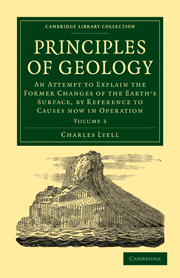 Principles of Geology
Principles of Geology Book contents
- Frontmatter
- PREFACE
- Contents
- LIST OF PLATES AND WOOD-CUTS IN THE THIRD VOLUME
- LIST OF WOOD-CUTS
- ERRATA
- CHAPTER I
- CHAPTER II
- CHAPTER III
- CHAPTER IV
- CHAPTER V
- CHAPTER VI
- CHAPTER VII
- CHAPTER VIII
- CHAPTER IX
- CHAPTER X
- CHAPTER XI
- CHAPTER XII
- CHAPTER XIII
- CHAPTER XIV
- CHAPTER XV
- CHAPTER XVI
- CHAPTER XVII
- CHAPTER XVIII
- CHAPTER XIX
- CHAPTER XX
- CHAPTER XXI
- CHAPTER XXII
- CHAPTER XXIII
- CHAPTER XXIV
- CHAPTER XXV
- CHAPTER XXVI
- Table I Showing the relations of the various classes of rocks, the Alluvial, the Aqueous, the Volcanic, and the Hypogene, of different periods
- Table II Showing the order of superposition of the principal European groups of sedimentary strata mentioned in this work
- Notes in explanation of the Tables of fossil shells in Appendix I
- Appendix I Tables of fossil shells by Monsieur G. P. Deshayes
- Appendix II Lists of fossil Shells chiefly collected by the author in Sicily and Italy, named by M. Deshayes
- Glossary, containing an explanation of geological and other scientific terms used in this work
- Index
- WORKS ON SCIENCE AND NATURAL HISTORY
- Plate section
- Frontmatter
- PREFACE
- Contents
- LIST OF PLATES AND WOOD-CUTS IN THE THIRD VOLUME
- LIST OF WOOD-CUTS
- ERRATA
- CHAPTER I
- CHAPTER II
- CHAPTER III
- CHAPTER IV
- CHAPTER V
- CHAPTER VI
- CHAPTER VII
- CHAPTER VIII
- CHAPTER IX
- CHAPTER X
- CHAPTER XI
- CHAPTER XII
- CHAPTER XIII
- CHAPTER XIV
- CHAPTER XV
- CHAPTER XVI
- CHAPTER XVII
- CHAPTER XVIII
- CHAPTER XIX
- CHAPTER XX
- CHAPTER XXI
- CHAPTER XXII
- CHAPTER XXIII
- CHAPTER XXIV
- CHAPTER XXV
- CHAPTER XXVI
- Table I Showing the relations of the various classes of rocks, the Alluvial, the Aqueous, the Volcanic, and the Hypogene, of different periods
- Table II Showing the order of superposition of the principal European groups of sedimentary strata mentioned in this work
- Notes in explanation of the Tables of fossil shells in Appendix I
- Appendix I Tables of fossil shells by Monsieur G. P. Deshayes
- Appendix II Lists of fossil Shells chiefly collected by the author in Sicily and Italy, named by M. Deshayes
- Glossary, containing an explanation of geological and other scientific terms used in this work
- Index
- WORKS ON SCIENCE AND NATURAL HISTORY
- Plate section
Summary
EOCENE FRESH-WATER FORMATIONS.
We have now traced back the history of the European formations to that period when the seas and lakes were inhabited by a few only of the existing species of testacea, a period which we have designated Eocene, as indicating the dawn of the present state of the animate creation. But although a small number only of the living species of animals were then in being, there are ample grounds for inferring that all the great classes of the animal kingdom, such as they now exist, were then fully represented. In regard to the testacea, indeed, it is no longer a matter of inference, for 1400 species of this class have been obtained from that small number of detached Eocene deposits which have hitherto been examined in Europe.
The celebrated Paris basin, the position of which was pointed out in the former part of this volume, (see wood-cut, p. 16) first presents itself, and seems to claim our chief attention when we treat of the phenomena of this era. But in order more easily to explain to the student the peculiar nature and origin of that group, it will be desirable, first, to give a brief sketch of certain deposits of Central France, which afford many interesting points of analogy, both in organic remains and mineral composition, and where the original circumstances under which the strata were accumulated may more easily be discerned.
- Type
- Chapter
- Information
- Principles of GeologyAn Attempt to Explain the Former Changes of the Earth's Surface, by Reference to Causes now in Operation, pp. 225 - 240Publisher: Cambridge University PressPrint publication year: 2009First published in: 1833


